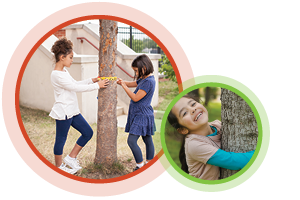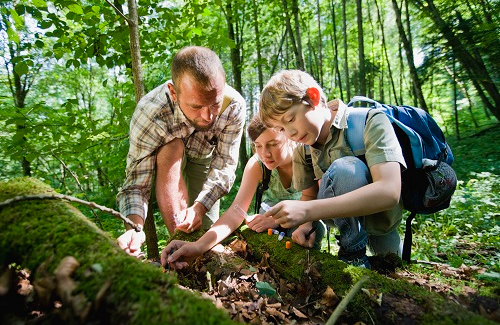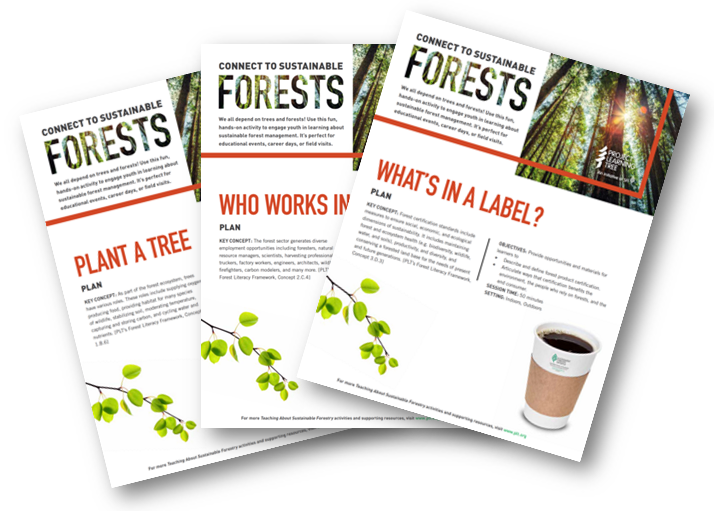February 12, 2021
As springtime approaches, the outdoors beckons as a place to learn, enjoy, and engage safely with others. International Day of Forests (March 21) is not coincidentally the first day of spring in the Northern Hemisphere. This year’s theme is “Forests and sustainable production and consumption.”
Whether to mark that Day or any other day of the year, PLT’s new Learn About Forests provides what you need. Learn About Forests consists of 12 free, hands-on activities to use with kids ages 10 to 16. Whether using one, several, or all of the activities, non-educators have an easy-to-follow path to confidently teach about themes related to sustainable forest management, stewardship, and green careers. These are topics that many of today’s young people want to know more about.
How to Start?
It’s hard for people not used to teaching kids to know how to translate good intentions into effective, age-appropriate lessons. That’s where Learn About Forests comes in. Weyerhaeuser Company partnered with PLT and the Sustainable Forestry Initiative to develop Learn About Forests in part to better equip its own natural resource professionals with a way to connect with students.
“One of the first questions our employees have when they reach out to schools is how to start,” said Laura Six, Ph.D., a plant ecology scientist with Weyerhaeuser and member of the PLT Education Operating Committee. “They are not sure which concepts to focus on or how to structure a lesson for a group.”

Each Learn About Forests activity is designed to take 50 minutes to complete and consists of five steps:
- Plan
- Background
- Prepare
- Lead
- Close
Simple procedures remove the mystery about how to engage learners with the topic.
A ‘Did You Know? Forest Fact’ and ‘Take Action’ suggestion are included as opportunities to extend the learning.
Tips and Tools for Working with Youth
If you’re new to working with youth, gain confidence from our supporting toolkit of tips and tricks, learn about collaborating with schools, and getting local support. Whether you draw from Learn About Forests or from other PLT resources, remember these basic, but essential tips and you’ll be a success:

- Know your audience. The way you present these activities will change depending on the knowledge, skills, and prior experiences of your learners and even yourself! Play to everyone’s strengths as much as possible.
- Adapt activities to your specific situation and comfort level. Don’t feel like you have to follow activity instructions to the letter.
- Tell a captivating story. You might start each activity sharing a personal anecdote from your own experience.
- Be brief. Limit your instructions to two or three steps.
- Set boundaries. For outdoor activities, create and communicate clear physical boundaries that provide a safe environment.
- If you have questions, ask! It’s okay to let youth know you don’t have all the answers, and it’s okay to ask for help—or search the internet for answers.
- Model thinking skills. When the group discovers something unfamiliar, you might say, “I don’t know–let’s explore that together” or “What do you think is the best solution?
- Silence is okay. Give youth adequate time to process information and respond.
- Focus on the experience. Try not to get bogged down in the details by encouraging youth to make their own observations, ask questions, and draw conclusions.
Rundown of Learn About Forests
Review the set or focus on a specific activity to tackle first:
- Every Tree for Itself: Explore how trees compete with each other for nutrients, sunlight, space and water
- Living with Fire: Explore the burnability of different fuels and the role of fire in ecosystems
- Make Your Own Paper: Experience magic in making an everyday product from a tree
 Nature’s Skyscrapers: Calculate the height of a tree and width of its trunk with simple tools
Nature’s Skyscrapers: Calculate the height of a tree and width of its trunk with simple tools
- Plant a Tree: Select the right type of tree for the site, plant it, and consider the many benefits of doing so
- Seeking Sustainability: Go global by identifying connections between forests and the United Nations’ Sustainable Development Goals
- Tree Cookies: Discover what a tree cross-section reveals about the past
- Trees in Trouble: Assess how healthy (or not) is a nearby tree
- Water Wonders: Model the paths of water molecules and their importance for all living things
- Web of Life: Create an ecosystem to learn about the interconnectedness of organisms
- What’s in a Label: Understand what certification is and why it matters
- Who Works in This Forest: Learn about forest-related careers, maybe even one for your students’ future.
If you’re inspired to help grow the next generation of environmental stewards and future conservation leaders, be sure to try these activities that make it easy to teach youth about forests!



